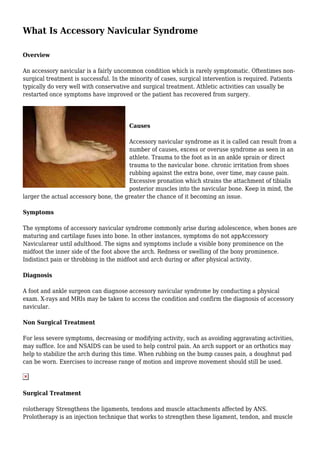
What Is Accessory Navicular Syndrome
- 1. What Is Accessory Navicular Syndrome Overview An accessory navicular is a fairly uncommon condition which is rarely symptomatic. Oftentimes non- surgical treatment is successful. In the minority of cases, surgical intervention is required. Patients typically do very well with conservative and surgical treatment. Athletic activities can usually be restarted once symptoms have improved or the patient has recovered from surgery. Causes Accessory navicular syndrome as it is called can result from a number of causes, excess or overuse syndrome as seen in an athlete. Trauma to the foot as in an ankle sprain or direct trauma to the navicular bone. chronic irritation from shoes rubbing against the extra bone, over time, may cause pain. Excessive pronation which strains the attachment of tibialis posterior muscles into the navicular bone. Keep in mind, the larger the actual accessory bone, the greater the chance of it becoming an issue. Symptoms The symptoms of accessory navicular syndrome commonly arise during adolescence, when bones are maturing and cartilage fuses into bone. In other instances, symptoms do not appAccessory Navicularear until adulthood. The signs and symptoms include a visible bony prominence on the midfoot the inner side of the foot above the arch. Redness or swelling of the bony prominence. Indistinct pain or throbbing in the midfoot and arch during or after physical activity. Diagnosis A foot and ankle surgeon can diagnose accessory navicular syndrome by conducting a physical exam. X-rays and MRIs may be taken to access the condition and confirm the diagnosis of accessory navicular. Non Surgical Treatment For less severe symptoms, decreasing or modifying activity, such as avoiding aggravating activities, may suffice. Ice and NSAIDS can be used to help control pain. An arch support or an orthotics may help to stabilize the arch during this time. When rubbing on the bump causes pain, a doughnut pad can be worn. Exercises to increase range of motion and improve movement should still be used. Surgical Treatment rolotherapy Strengthens the ligaments, tendons and muscle attachments affected by ANS. Prolotherapy is an injection technique that works to strengthen these ligament, tendon, and muscle
- 2. attachments by causing a mild anti-inflammatory response in the tissues. Prolotherapy supports the body’s normal healing response to injury. The solution directed at the injured and weakened tissue will cause an influx of blood supply and regenerative cells to come to the area. As part of this healing cascade, collagen cells will also be deposited at the injured site. The tissue, which is made mostly of collagen, will become stronger and tighter as these new collagen cells mature. The injured tissue becomes healthy again. When the weakness or injury in these structures is resolved, often times the symptoms with ANS are resolved and the patient no longer suffers from chronic foot pain. In our experience, patients typically feel better soon after treatment. However, if the person desires to run again or continue to be very active, it may take 3-5 treatments to fully resolve the condition. Activity is increased during treatment as symptoms resolve.